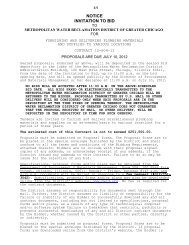Budget Message / Highlights - Metropolitan Water Reclamation ...
Budget Message / Highlights - Metropolitan Water Reclamation ...
Budget Message / Highlights - Metropolitan Water Reclamation ...
Create successful ePaper yourself
Turn your PDF publications into a flip-book with our unique Google optimized e-Paper software.
METROPOLITAN WATER RECLAMATION DISTRICT OF GREATER CHICAGO<br />
2009 BUDGET<br />
seeks to upgrade the recreational and aquatic use designations for the Chicago Area <strong>Water</strong>ways (CAWs) and Lower Des<br />
Plaines River.<br />
If enacted as proposed, the rules would require the District to disinfect the effluent from its Stickney, Calumet and<br />
North Side <strong>Water</strong> <strong>Reclamation</strong> Plants (WRPs), and increase the level of dissolved oxygen (DO) in certain segments of<br />
the CAWs. The District’s preliminary estimate of the capital costs associated with disinfection at these three WRPs<br />
range from approximately $963,000,000 to $2,153,000,000. The capital cost of flow augmentation or supplemental<br />
aeration just for the Upper North Shore Channel, the North and South Branches of the Chicago River, and the South<br />
Fork of the South Branch of the Chicago River, that is necessary to comply with the proposed DO standards in these<br />
stretches of the CAWs 90 percent of the time ranges from approximately $204,480,000 to $352,480,000.<br />
The District has initiated a number of water quality studies designed to supplement the rulemaking and ensure that any<br />
rules adopted are scientifically sound, technically feasible, and economically reasonable. The following studies either<br />
have been completed or are on-going:<br />
• Spatial and Temporal Characterization of Fecal Coliform in the CAWs: The District initiated a three-year<br />
study of fecal coliform distribution in the North Shore Channel/North Branch Chicago River (NSC)/(NBCR) and<br />
Little Calumet River/Calumet-Sag Channel Systems in 2004. The study was designed to determine the<br />
concentration of fecal coliform across these CAWs reaches that are typically observed during dry and wet weather<br />
and to determine the change in concentrations that occurs across each reach following wet weather events. The field<br />
sampling was concluded in 2006 and a final report was produced in 2007. The report indicates that imposition of<br />
the effluent fecal coliform standards proposed in the UAA rulemaking will not result in attainment of 400<br />
CFU/100mL in the waterways due to fecal coliform concentrations being much higher than this concentration<br />
upstream of the North Side and Calumet WRPs and in tributary flows, and during wet weather which exerts an<br />
influence on CAWs water quality with respect to bacterial concentration a minimum of 60 percent of the time<br />
throughout the year. This study indicates that effluent disinfection will not provide any significant improvement in<br />
water quality in the CAWs and highlights the need to determine the levels of fecal coliform in the CAWs that are<br />
protective of identified recreational uses. The District has initiated a follow-up study to assess non-point sources of<br />
E. coli in the CAWs in collaboration with the United States Geological Society’s Lake Michigan Ecological<br />
Research Station. This study will continue through 2010.<br />
• USEPA Bacterial <strong>Water</strong> Quality Criteria Review: In 2004, the District convened a panel of experts to review the<br />
applicability of the USEPA’s 1986 criteria and the draft 2003 guidance for setting bacterial water quality standards<br />
in the CAWs. The expert panel, chaired by Dr. Charles Haas of Drexel University, and including Drs. Joan Rose of<br />
Michigan State University, Herbert Allen of the University of Delaware, and Abdel Al-Shaarawi of Environment<br />
Canada concluded that there are currently no criteria available to derive a science based water quality standard that<br />
is protective of secondary contact type recreational uses such as are occurring on the CAWs. The expert panel<br />
recommended that the District conduct a quantitative microbial risk assessment and/or an epidemiological study of<br />
CAWs recreators to determine the relationship between water quality and risk of illness among recreational users of<br />
the CAWs.<br />
• Quantitative Microbial Risk Assessment for CAWs Recreational Users: In 2005 the District, in partnership<br />
with its consultants GeoSyntec Consultants, Dr. Charles Gerba of the University of Arizona, Clancy Environmental<br />
Consultants, Inc., Hoosier Microbiological Laboratory, Inc., Patterson Environmental Consultants, and Cecil Lue-<br />
Hing and Associates, initiated a quantitative microbial risk assessment for recreational uses identified as occurring<br />
under the IEPA’s UAA on the CAWs. The study consisted of sampling and determining microbiological water<br />
quality during dry and wet weather conditions including effluent, and upstream and downstream of the Stickney,<br />
Calumet, and North Side WRPs and major Combined Sewer Overflow (CSO) pump stations. Analytical parameters<br />
included fecal coliform, E. coli, enterococci, Pseudomonas aeruginosa, Salmonella spp., infectious<br />
Cryptosporidium parvum, viable Giardia lamblia, total culturable viruses, viable adenovirus, and Calicivirus. State<br />
of the art risk modeling was utilized along with use observation data from the UAA Study to simulate the risk to<br />
recreators due to incidental contact and non-contact recreational use of the CAWs. An interim dry weather risk<br />
assessment report was completed in 2006 and the final study report was completed in April 2008. The study<br />
indicates that current recreational practices on the CAWs pose very low risk to recreators below the 10 and 14<br />
illnesses/1000 recreational events, which IEPA has set as an acceptable threshold for incidental and non-contact<br />
recreation in the CAWs UAA Report.<br />
• Epidemiological Study of Incidental Contact and Non-Contact Recreation on the CAWs: The District has<br />
initiated an epidemiological study of CAWs recreators through the University of Illinois at Chicago School of<br />
Public Health. This state of the art study was initiated in 2007 and will validate the results of a recently completed<br />
5<br />
5
















